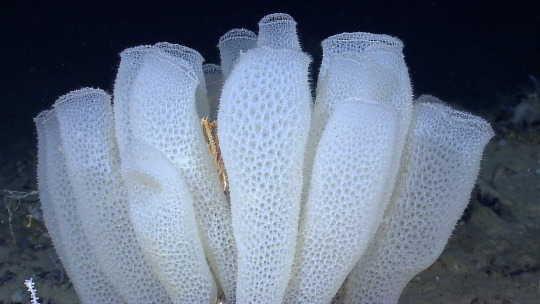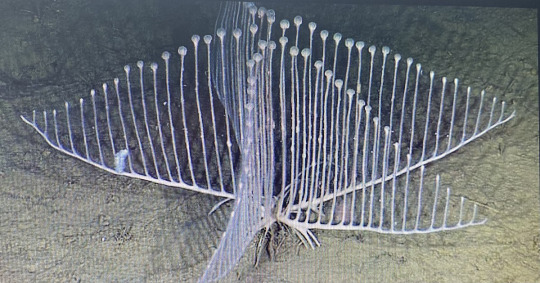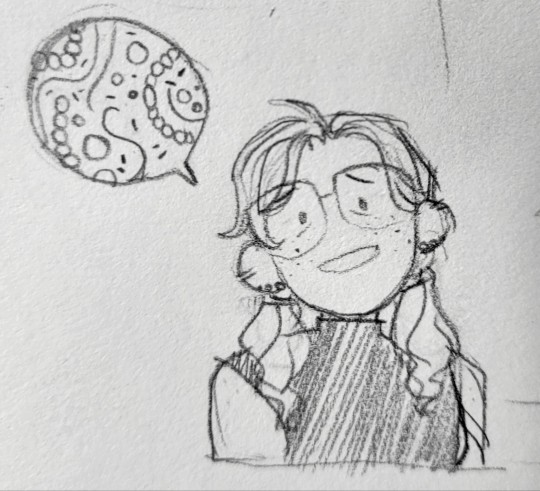#multicellularity
Explore tagged Tumblr posts
Text
SciTech Chronicles. . . . . . . . .April 22nd, 2025
#pour-over#avalanches#flavor#gooseneck#interfaces#“emergent properties”#multicellularity#“Metabolic Topography”#capacity#splits#“Agentic AI”#“RF Plant”#“algal blooms”#“Greenland Ice Sheet”#phosphorus#nitrogen Tags:#volatile-rich#controlled-source#seismic#imaging
0 notes
Text
A Multitalented Scientist Seeks the Origins of Multicellularity
0 notes
Text
While mushrooms and animals evolved multicellularity independently, it's true that they have much in common - their metabolisms are closer to each other than to that of plants, meaning sessile animals and (macroscopic) fungi will have similar needs, and will absolutely evolve the same vibes sometimes!
Phylum #2: Porifera, the sponges!


While not the most basal animals, sponges are probably the closest to what the first animals looked like. The basic shape is pretty simple: a surface covered in numerous pores takes in water, funneling it out through a large chimney.
The cells in charge of driving water through the pores, choanocytes, are surprisingly close in function to our closest unicellular relatives, choanoflagellates, hinting at a deep evolutionary connection between us and them. It is believed that the first sponge-like animals arose through multiple choanoflagellate-like cells sticking together, beating their flagella in tandem to filter water together!
While the basic sponge body plan is pretty simple, they have evolved numerous variations on it. Glass sponges have become delicate creatures built upon a silica skeleton, and have been reported to live for up to tens of millenia at the bottom of the ocean!
Meanwhile, deep-water carnivorous sponges capture small prey like crustaceans, with velcro-like hooks and enigmatic balloon-like structures!


#forms and phyla#not a phylum post#animals#fungi#multicellularity#if someone who knows more about fungi than me could add their knowledge it would be amazing
341 notes
·
View notes
Text
All bacteria exist as single cells at some point in their lives – except for one kind, known as multicellular magnetotactic bacteria (MMB), that is. Scooped from the sulfide-laden sediments of a tidal salt marsh in Massachusetts, scientists think these MMBs could provide clues to our own evolutionary history, as a kind of missing link between simple, single-celled life forms and complex multicellular organisms like ourselves.
Continue Reading.
70 notes
·
View notes
Note
can I just say, I followed you for your beautiful art style and use of colours and I stayed for your beautiful art style and use of colours AND cyanobacteria. Like, I know nothing about them because I'm a classic lit major but more often than not I find myself reading your posts about cyanobacteria with unexpected interest and fascination

HAH! I'm glad u enjoy them bc I feel absolutely intolerable when I talk abt them lol. But also. I am the cyanobacteria evangelist. I am the patron saint of cyanobacteria.
#mostly bc it just feels like no one cares and then even if they care a lil they care in the most boring way possible#like i dont care abt cyanos from the perspective of usefulness or as a toxic threat or relative to plants#i just think theyre cool independent of all that! theyre the only multicellular bacteria! they're complex and do interesting things!#billions of years ago they aquired the abilty to reach out toward a distant star and aquire its energy#and they became so good at it that everyone started stealing their power. and i kno im being pedantic when i get annoyed when ppl r like oh#they're like microscopic plants or plants do photosynthesis but also other stuff does too. bc its like. no. u got it all backwards cyanos#did photosynthesis 1st and were the best to ever fucking do it. they r the most important organisms to ever exist on this planet aside from#THE universal common ancestor and u r barely mentioning them and if u do ur sidelining them. and it feels like im the only one who cares. i#was talking to my lab mate abt this and she was like: i feel like if u post abt cyanobacteria on the internet u open urself up to being#harrassed by me specifically lol. so i should post abt them more and force myself to read more papers but idk it jsut feels like screaming#into the void. whatever. im just happy i kinda kno the phylogeny now#also the fact that cyanos r interesting comes as a surprise is prob bc again everyone talks abt them in the most boring ways possible#i just dont care about anything useful. i just want to do interesting science. basic research. lets see whats out there type stuff#as the government is attempting to strangle academia to death. ugh#unrelated
29 notes
·
View notes
Text
the mitochon-chia is the powerhouse of the cell.......

#neotag#does this mean the chia is a unicellular organism now or something#chia is not a veterbrate not even a multicellular thing#is chia.....slime mold?#i am not a biology major disclaimer shitpost may be inaccurate
11 notes
·
View notes
Text

the empire grows
6 notes
·
View notes
Text
Daily Fungi Fact 16: The (maybe)fungi Ourasphaira giraldae is an extinct species on land that lived over 1 billion years ago, that was before plants were on land. Most experts believe that fungi colonized land before plants grew on land, however fungi fossils from before the Devonian period are rare and often disputed, this is due to fungal fruiting bodies being easily degradable and most fungi structures being microscopic, leading to many fungi fossils resembling other microscopic organisms.
4 notes
·
View notes
Text
having a background in biology is its own little curse because I'll be wiping down the shower wall and thinking "gee this is probably slime mold! which means it has Thoughts"
#at least it probably can't feel pain#but what are we if not extremely complex colonial organisms?#multicellular creatures only evolved because a colony of single-celled organisms got too specialized#and we know at least some slime molds can solve maze puzzles just like a rat!#so like... if that was armageddon to you pink shower slime... I'm sorry 😔
2 notes
·
View notes
Text
Four billion years ago complex multicellular life forms evolved temporarily before rapidly going extinct, leaving behind only trace fossils from which their existence can be inferred.
2 notes
·
View notes
Text
i love TAing. some parts of it are stressful but running office hours and just getting to talk through a concept with the students until we've identified the source of their confusion and successfully resolved it is so satisfying and fun.
#and i know a bunch of fun facts to throw in that they appear to find genuinely fun!#e.g. 'worms are one of the only commonly studied multicellular organisms that we can freeze'#which is always a real hit.#a couple of them asked me to explain my research to them today???#and they said they thought it sounded 'cool' and 'sci-fi'#which makes me feel :')#and they asked for grad school advice! i feel so USEFUL. they're so likeable and interested in stuff#even the ones who are clearly suffering under the weight of only being kind of interested and really wanting to pass the class#1. are showing up and asking questions! which i appreciate!#2. are obviously trying to think through the concepts and light up when something becomes less confusing#and i am very grateful to them for putting in the effort. and i hope i repaid it with useful information about how to pass the exam.#box opener
18 notes
·
View notes
Text
Meet the first animal found that doesn't need oxygen to live
In 2020, scientists discovered a jellyfish-like parasite that lacks a mitochondrial genome – the first multicellular organism ever found with such an absence. This means it doesn't breathe; in fact, he lives completely free from oxygen dependence.
Species Henneguya salminicola

This discovery doesn't just change our understanding of how life might work here on Earth – it could also have implications for the search for extraterrestrial life. Life began developing the ability to metabolize oxygen – that is, breathe – more than 1, 45 billion years. A larger archaeon engulfed a smaller bacterium, and somehow the bacterium's new home was beneficial to both parties, and the two remained together.
This symbiotic relationship resulted in the joint evolution of the two organisms and, eventually, the bacteria installed in them became organelles called mitochondria. Every cell in your body, except red blood cells, has a large number of mitochondria, and these are essential for the respiratory process.
They break down oxygen to produce a molecule called adenosine triphosphate, which multicellular organisms use to power cellular processes.
We know that there are adaptations that allow some organisms to thrive in low-oxygen or hypoxic conditions. Some unicellular organisms have developed mitochondria-related organelles for anaerobic metabolism; but the possibility of exclusively anaerobic multicellular organisms has been the subject of some scientific debate.
That was until a team of researchers led by Dayana Yahalomi of Tel Aviv University in Israel decided to take a new look at a common salmon parasite called Henneguya salminicola.
It is a cnidarian, belonging to the same phylum as corals, jellyfish and anemones. Although the cysts it creates in the fish's flesh are unsightly, the parasites are not harmful and will live with the salmon throughout its life cycle.
Hidden within its host, the tiny cnidarian can survive quite hypoxic conditions. But it's difficult to know exactly how this happens without looking at the creature's DNA – and that's what the researchers did.
They used deep sequencing and fluorescence microscopy to conduct a detailed study of H. salminicola and discovered that it had lost its mitochondrial genome. Furthermore, it has also lost the capacity for aerobic respiration and almost all nuclear genes involved in the transcription and replication of mitochondria. Like unicellular organisms, it has developed organelles related to mitochondria, but these are also unusual – they have folds in the inner membrane that normally are not seen.
The same sequencing and microscopic methods in a closely related cnidarian fish parasite, Myxobolus squamalis, were used as a control and clearly showed a mitochondrial genome.
These results showed that here was, finally, a multicellular organism that did not need oxygen to survive.
Although H. salminicola is still a mystery, the loss is largely consistent with a general trend in these creatures – a trend toward genetic simplification. Over many, many years, they basically evolved from a free-living jellyfish ancestor into the much simpler parasite we see today.
They lost most of the original jellyfish genome, but retained – strangely – a complex structure reminiscent of jellyfish stinging cells. They don't use them to sting, but to cling to their hosts: an evolutionary adaptation of the free-living jellyfish's needs to those of the parasite. You can see them in the image above – they're things that look like eyes.
The discovery could help fisheries adapt their strategies to deal with the parasite; although it's harmless to humans, no one wants to buy salmon full of strange little jellyfish.
But it's also an incredible discovery to help us understand how life works.
“Our discovery confirms that adaptation to an anaerobic environment is not exclusive to single-celled eukaryotes, but also evolved in a multicellular parasitic animal,” the researchers explained in their paper, published in February 2020.
“Therefore, H. salminicola provides an opportunity to understand the evolutionary transition from an aerobic to an exclusively anaerobic metabolism.”
The research was published in PNAS .
#mitochondrial genome#first animal that doesn't need oxygen#anaerobic environment#Henneguya salminicola#multicellular parasitic animal#science#2020
2 notes
·
View notes
Text
sometimes i think i'm making up my anxiety for attention and then i spend lots of time being... anxious... about it. brains are so bizarre and cruel i don't want mine anymore
2 notes
·
View notes
Text
Morphodynamics of human early brain organoid development
Experimental methods Stem cell and organoid culture We used the following induced pluripotent stem (iPS) cell line for all experiments (also see Supplementary Methods Table 1): histone2B–mEGFP that uniformly labels nuclei (cell line ID: AICS-0061-036, cl.036), mEGFP–β-actin that uniformly labels ACTB (cell line ID: AICS-0016-184 cl.184), mTagRFP–T-CAAX that labels cell membrane (cell line ID:…
#Humanities and Social Sciences#Image processing#Morphogenesis#Multicellular systems#multidisciplinary#Neural stem cells#Science#Time-lapse imaging
0 notes
Text
why can rotifers get pregangenant
1 note
·
View note
Text
LET THEM BE CORAL
Also in what fucking universe are corals almost protists

who let biologists play dnd
#Snail rebubbles#D&D#marine biology#corals are cnidarians#Like very specifically if you're allowed to be a man o war you should be allowed to be a coral#they're both a bunch of cnidarians stuck together#You can't just go calling every multicellular animal you don't like a protist words mean things#...were they thinking of sponges???#I can *sort of* see the argument for sponges#with the minimal tissue differentiation and the amebocyte trick
59K notes
·
View notes